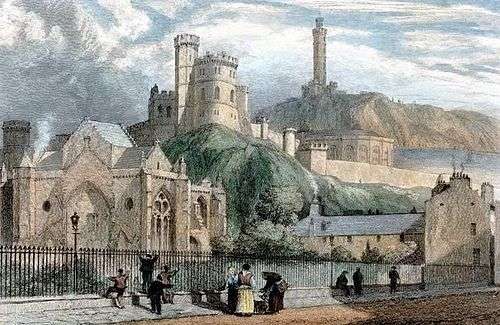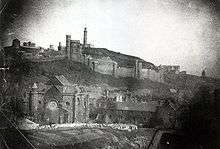Trinity College Kirk




Trinity College Kirk was a royal collegiate church in Edinburgh, Scotland. The kirk and its adjacent almshouse, Trinity Hospital, were founded in 1460 by Mary of Gueldres in memory of her husband, King James II. Queen Mary was interred in the church, until her coffin was moved to Holyrood Abbey in 1848.[1]
The church and hospital of Soutra Aisle dedicated to the Holy Trinity, was held as a prebend of the chancellor of St Andrews.[2] In 1459/60 the chancellorship was vacant allowing the dowager queen to supplicate Pope Pius II for the annexation of Soutra to her Trinity College foundation – the sanctioning bull was published on 23 October 1460.[2] Queen Mary issued a charter on 25 March 1462 detailing the constitution for Trinity College in which the provost was to hold Soutra church as a prebend but had to maintain three bedesmen in the Soutra hospital.[2]
Early records of the construction of the church are lost, but on 8 April 1531 the Provost Master John Dingwall contracted with a mason Robert Dennis that Dennis would work to complete the building for his lifetime. Dingwall wished to complete the church conforming to the choir. After his death in 1533, the masons pursued his legacy left for completing the work. Only the choir and transepts were finished. A nearby house, demolished in 1642, was called 'Dingwall Castle.' After the Scottish Reformation the kirk became the North East Quarter Church of Edinburgh. During the 1590s, the kirk was used by Edinburgh University for graduation ceremonies.[3]
Built in the shadow of Calton Hill, the gothic kirk, and its associated hospital, were demolished in 1848 under the careful supervision of the Edinburgh architect David Bryce, despite a formal protest from the Society of Antiquaries of Scotland, to allow for the construction of Waverley Station.[4][5] David Octavius Hill and Robert Adamson managed to take some photographs of the kirk before its demise. It was carefully dismantled and each piece of masonry was numbered with the intention of reconstructing the kirk on another site. Edinburgh Town Council received £16,000 from the North British Railway Company for the purpose of reconstructing the building, or building a substitute, but the funds were never used.[6] However, one transept and the choir were reconstructed in the 1870s, on Chalmers Close, just off the Royal Mile, and, under the name Trinity Apse, formerly housed the Brass Rubbing Centre, under the auspices of the City of Edinburgh Council.
The rebuilt Apse, together with carved stone fragments and the boundary wall, is registered as a Category A listed building by Historic Scotland and can now be hired as a venue for small events.[7]
List of provosts
- Edward Bonkle: 1462 – 1495 x 1496
- James Oliphant: 1499 – 1525
- John Brady: 1502 – 1525
- John Dingwell: 1525 – 1532 x 1533
- William Cunningham: 1533 – 1539
- Thomas Erskine: 1539
- Robert Erskine: 1539 – 1540
- George Clapperton: 1540 – 1566
- Laurence Clapperty: 1566 – 1571 x 1572
- Robert Pont: 1572 – 1586
Source: Watt & Murray Fasti Ecclesiae Scoticanae
Note: One of the founding members of the College of Justice, John Dingwell, was Provost of Trinity College; and several Moderators of the General Assembly of the Church of Scotland came from the Trinity College Kirk:
- 1690 Hugh Kennedie AM
- 1719 James Grierson
- 1739 James Bannatyne
- 1740 George Logan
See also
- Berwick Castle, most of which was also demolished in 1847, to allow for the construction of the Edinburgh - Newcastle railway
Notes
- ↑ "Notes on the disputed tomb of Mary of Gueldres" (PDF).
- 1 2 3 Cowan & Easson, Medieval Religious Houses, p. 192
- ↑ Marwick (1891), 26-29, 65, 89, 130, 131 note.
- ↑ A Calotype View of Trinity College Church, Edinburgh, by Hill & Adamson, Graham Smith, the Burlington Magazine, Vol. 126, No. 981
- ↑ "Calotype of Trinity College Church". City of Edinburgh Council - Capital Collections. Edinburgh.
- ↑ Macphail's Edinburgh ecclesiastical journal and literary review, Volume XVII
- ↑ http://www.edinburghmuseums.org.uk/Venues/Brass-Rubbings-Centre-(1)
References
- Colston, James, (1896/1897),Trinity College and Trinity Hospital Edinburgh, Magistrates and Town Council Edinburgh, Edinburgh, 2 Volumes.
- Cowan, Ian B. & Easson, David E., (1976), Medieval Religious Houses Scotland, Longman, London. ISBN 0-582-12069-1
- Marwick, James, (1891), History of the Church of Holy Trinity and Hospital, Edinburgh, Burgh Records Society, Edinburgh.
- Watt, D.E.R.and Murray, A. L. (2003), Fasti Ecclesiae Scoticanae Medii Aevi Ad Annum 1638', The Scottish Record Society, Edinburgh. ISBN 0-902054-19-8
External links
| Wikimedia Commons has media related to Trinity College Kirk. |
- Photographs of a communion plate, 2 communion cups and 2 communion flagons associated with Trinity College Kirk, Edinburgh; National Museums Scotland
- Archive of images of the kirk, held by the Royal Commission on the Ancient and Historical Monuments of Scotland
- Image of Trinity Hospital, held by the Royal Commission on the Ancient and Historical Monuments of Scotland
- Photograph of a transept window, University of Glasgow
- Brass Rubbing Centre, the City of Edinburgh Museums & Galleries
Coordinates: 55°57′10″N 3°11′10″W / 55.95278°N 3.18611°W